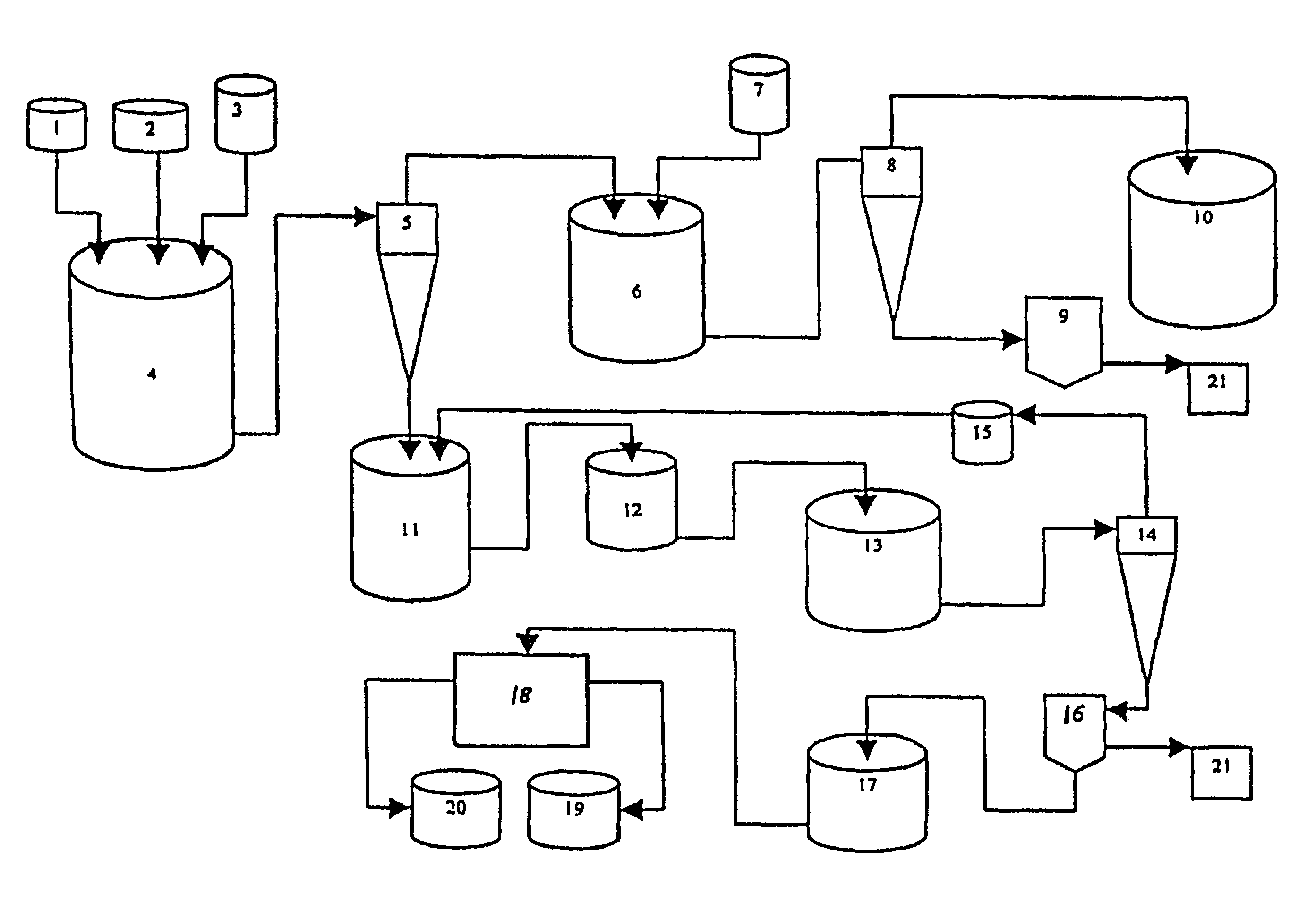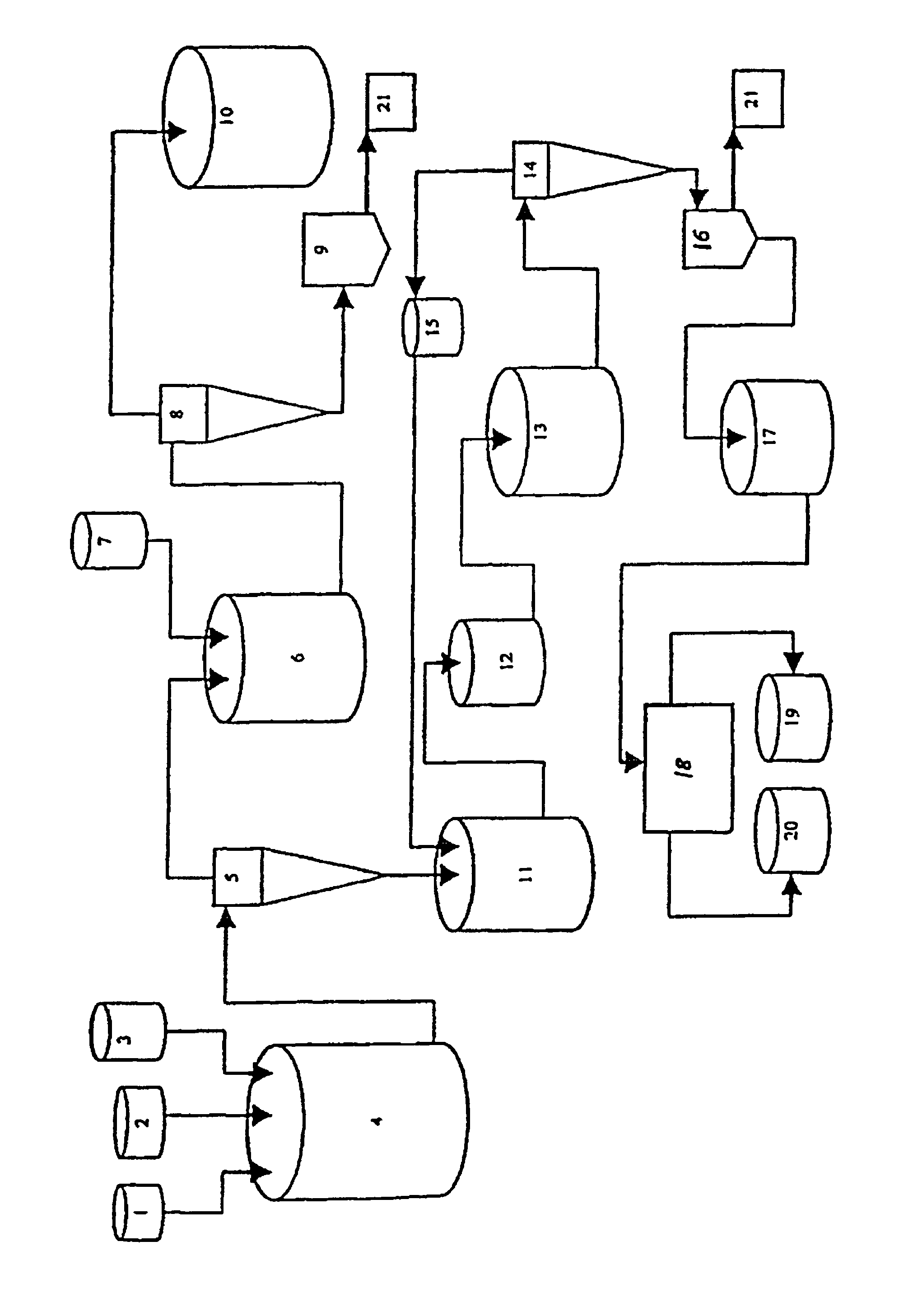Method and installation for the treatment of radioactive wastes
a radioactive waste and installation method technology, applied in the direction of electrokinetic cell fluid pressure measurement, semi-permeable membrane, electrolysis components, etc., can solve the problems of high temperature, large heat energy consumption, complex process,
- Summary
- Abstract
- Description
- Claims
- Application Information
AI Technical Summary
Benefits of technology
Problems solved by technology
Method used
Image
Examples
example 1
[0054]A litter radioactive waste with pH 8.0 containing 35 g / l boron acid (boron salts) is mixed with radioactive waste with pH 10.1 with mol ratio Na / B=0.5, containing 150 g / l boron salts (NaBO2) until the mixture reaches a pH of 9.1.
H3BO3+NaBO2→Na2B4O7
[0055]Sodium tetraborate is obtained, which maintains 20-25 g / l concentration in the solution. The remaining quantities over that concentration of borax are separated as crystals with a size of more than 0.5 mm. The mol ratio is maintained at Na / B=0.5 during the running of this process.
[0056]After the separation of the borax as a crystal mass, 9.0 ml solution of calcium nitrate with a concentration of 900 g / l is added to the rest of the liquid radioactive waste until reaching the mol ratio of Ca / B=0.25 to 0.35.
Na2B4O7+Ca(NO3)2→Ca2B6O11
[0057]The separated calcium hexaborate is subjected to multiple washings with water and is separated as non-radioactive product. The liquid waste, after the separation of the calcium hexaborate and wa...
example 2
[0059]One liter of radioactive waste with a pH of 10.0 with mol ratio Na / B=1 containing 200 g / l boron acid (boron salts NaBO2) is mixed with radioactive waste with pH of 4.0 until the mixture reaches a pH of 9.1.
HNO3+NaBO2→Na2B4O7
[0060]Sodium tetraborate is obtained, which maintains 20-25 g / l concentration in the solution. The rest over than this concentration borax quantities are separated as crystals with a size of more than 0.5 mm. This process runs at a constant mol ratio of Na / B=0.6.
[0061]After borax separation as a hard crystal phase to residual liquid radioactive waste, 9.4 milliliters of magnesium-chloride solution with a concentration of 500 g / l. is added until reaching a mole ratio of Mg / B=0.25 to 0.35.
Na2B4O7+MgCl2→Mg2B6O11
[0062]During mixing with magnesium oxide or magnesium hydroxide is separated at the same time with the separation of the hardly dissolving magnesium hexaborate and sodium hydroxide, which could be used for the initial correction of the pH of the radio...
PUM
| Property | Measurement | Unit |
|---|---|---|
| concentration | aaaaa | aaaaa |
| temperature | aaaaa | aaaaa |
| concentration | aaaaa | aaaaa |
Abstract
Description
Claims
Application Information
 Login to View More
Login to View More - R&D
- Intellectual Property
- Life Sciences
- Materials
- Tech Scout
- Unparalleled Data Quality
- Higher Quality Content
- 60% Fewer Hallucinations
Browse by: Latest US Patents, China's latest patents, Technical Efficacy Thesaurus, Application Domain, Technology Topic, Popular Technical Reports.
© 2025 PatSnap. All rights reserved.Legal|Privacy policy|Modern Slavery Act Transparency Statement|Sitemap|About US| Contact US: help@patsnap.com


